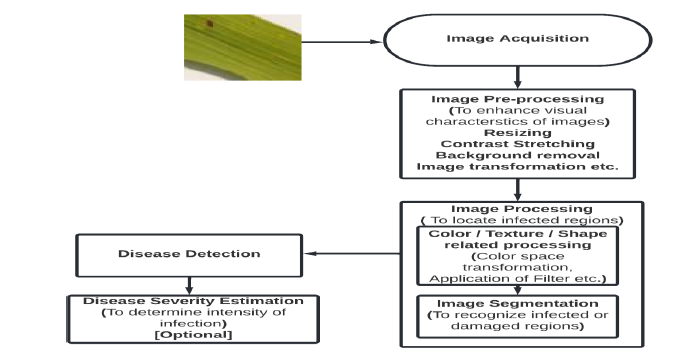Image Processing based Plant Disease Detection and Classification
Main Article Content
Abstract
Generally, it has been observed that due to lack of proper knowledge of disease intensity, the farmer is not able to use the pesticide in proper quantity to treat the diseases. The use of pesticide mostly becomes more than necessary, due to which there is not only a loss of money, but also it causes soil and environmental pollution. If diseases severity-wise labelled data sets are available, it can be used to develop pesticide recommendation systems. Images with least infection severity can be used to train and validate a DL model to capture the plant diseases at very initial stage. Classification techniques may be viewed as variations of detection systems; however, instead of attempting to identify only one particular illness among several diseases, classification methods detect and name the diseases harming the plant. This presents various classification and plant disease detection methods based on image processing with results.
Article Details
References
Upadhyay, S.K., Kumar, A. (2022). A novel approach for rice plant diseases classification with deep convolutional neural network. International Journal of Information Technology 14, pp.185–199 (2022). https://doi.org/10.1007/s41870-021-00817-5
Sabrol, H., Kumar, S. (2015). Recent studies of image and soft computing techniques for plant disease recognition and classifcation. International Journal of Computer Application 126(1): pp. 44–55. https://doi.org/10.5120/ijca2 015905982
Singh, V., Gupta, S., Saini, S. (2015a). A methodological survey of image segmentation using soft computing techniques. In: Conference proceeding— 2015 international conference on advances in computer engineering and applications, ICACEA 2015, pp 419–422. https://doi.org/10.1109/ICACEA.2015.7164741
Singh, V., Varsha, Misra, A.K. (2015b). Detection of unhealthy region of plant leaves using image processing and genetic algorithm. In: Conference proceeding—2015 International conference on advances in computer engineering and applications, ICACEA 2015, pp 1028–1032. https://doi.org/10.1109/ICACE A.2015.7164858
Szegedy, C., Liu, W., Jia, Y., Sermanet, P., Reed, S., Anguelov, D., Arbor, A., 2015. Going deeper with convolutions. In: 2015 IEEE Conference on Computer Vision and Pattern Recognition (CVPR). Boston, MA, USA, pp. 1– 9.
LeCun, Y., Bengio, Y., Hinton, G., (2015). Deep learning. Nature 521, 436– 444
Cruz AC, Luvisi A, De Bellis L and Ampatzidis Y (2017). X-FIDO: An Effective Application for Detecting Olive Quick Decline Syndrome with Deep Learning and Data Fusion. Frontiers in Plant Science 8:1741.doi: 10.3389/fpls.2017.01741
Redmon, J., Divvala, S., Girshick, R., and Farhadi, A. (2016). You only look once: Unified, real-time object detection. In Proceedings of the IEEE conference on computer vision and pattern recognition (pp. 779-788).
Gour, M., Jain, S. (2020). Stacked convolutional neural network for diagnosis of covid-19 disease from x-ray images. arXiv preprint arXiv:2006.13817.
Gour, M., Jain, S., and Kumar, T. S. (2020). Residual learning-based CNN for breast cancer histopathological image classification. International Journal of Imaging Systems and Technology, 30(3), pp.621-635.
Abdel-Hamid, O., Mohamed, A.R., Jiang, H., Deng, L., Penn, G., Yu, D. (2014). Convolutional neural networks for speech recognition. IEEE/ACM Trans. Audio, Speech, Language Process. 22 (10), 1533–1545.
Russakovsky, O., Deng, J., Su, H., Krause, J., Satheesh, S., Ma, S. et al. (2015). Imagenet large scale visual recognition challenge. International Journal of Computer Vision 115: 211–252.

